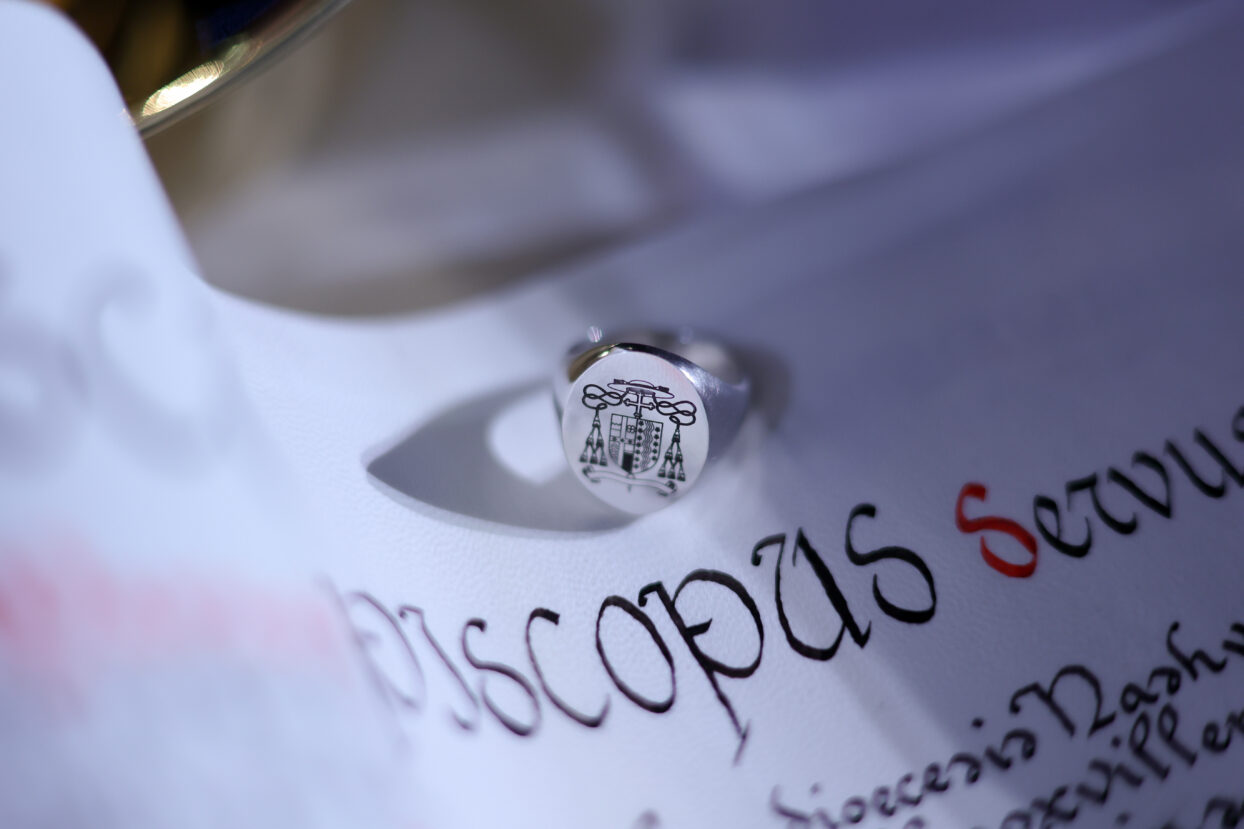Pontificals symbolize the key elements of a bishop’s office
By Dan McWilliams
With his ordination as the Diocese of Knoxville’s fourth shepherd come several important symbols of his new office for Bishop Mark Beckman.
Bishop Beckman chose an episcopal motto, “Jesus Christ Yesterday Today and Forever,” in the weeks leading up to his ordination, and a coat of arms bearing the motto was then designed for him.

Archbishop Shelton J. Fabre, principal consecrator for the ordination and installation of Bishop Mark Beckman, places the miter on Bishop Beckman, who was kneeling for the important liturgical moment. Seminarian Bobby Denne is assisting. (Photo Gabrielle Nolan)
At the ordination and installation Mass on July 26, the new bishop received his crosier (or shepherd’s staff) along with his ring and miter.
Bishop Beckman’s coat of arms, or crest, was designed by Father Philip G. Bochanski, a priest in residence at the Cathedral of Sts. Peter and Paul in Philadelphia and vicar general and moderator of the curia for the Archdiocese of Philadelphia.
Father Bochanski has served the Church at the local and national levels for nearly 25 years as a parish priest, a high-school religion teacher, a spiritual director, a chaplain to the Philadelphia chapter of Courage, and as the executive director of Courage International. Ordained in 1999, he also has served the Church of Philadelphia as a chaplain to consecrated religious communities and as a spiritual director for seminarians.
Father Bochanski is the author of six books, five sets of audio lectures, and numerous articles and book chapters addressing various topics such as Church history, spirituality, evangelization, and pastoral care. His most recent book, Wisdom of the Desert Fathers: Ancient Advice for the Modern World, was published by TAN Books in April 2020.
Father Bochanski has served as a consultant to the Subcommittee for the Promotion and Defense of Marriage and to the Institute on the Catechism, both within the U.S. Conference of Catholic Bishops.
In December 2019, Pope Francis awarded him the Cross Pro Ecclesia et Pontifice. The ability to bestow this honor is reserved for the Supreme Pontiff, and it is given in recognition of sustained and exceptional service to the universal Church.
Coats of arms in the Diocese of Knoxville
The original Diocese of Knoxville coat of arms was designed in 1988 by Deacon Paul Sullivan. Deacon Sullivan also designed the coat of arms for the diocese’s first shepherd, Bishop Anthony J. O’Connell, and the crest for its second shepherd, Bishop Joseph E. Kurtz. Father Bochanski also designed the coat of arms for the diocese’s third bishop, Bishop Emeritus Richard F. Stika.
Knoxville’s former bishops’ mottos were “The Harvest Is Plenty” (O’Connell), “Hope in the Lord” (Kurtz), and Iesu Confido in Te (“Jesus I Trust in You”) (Stika).
In designing the shield—the central element in what is formally called the “heraldic achievement”—a bishop has an opportunity to depict symbolically various aspects of his own life and heritage and to highlight aspects of Catholic faith and devotion that are important to him. The formal description of a coat of arms, known as the “blazon” (see the box above), uses a technical language derived from medieval French and English terms, which allows the appearance and position of each element to be recorded precisely.
A diocesan bishop shows his commitment to the flock he shepherds by combining his personal coat of arms with that of the diocese, in a technique known as “impaling.” The shield is divided in half along the pale, or central vertical line. The arms of the diocese appear on the “dexter” side—that is, on the side of the shield to the viewer’s left, which would cover the right side (in Latin, dextera) of the person carrying the shield. The arms of the bishop are on the “sinister” side—the bearer’s left, the viewer’s right.
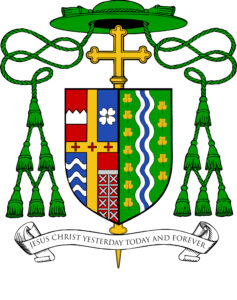 The central feature of the arms of the Diocese of Knoxville is a cross in gold (Or) taken from the arms of Pope St. John Paul II, who established the diocese. Three small red (gules) crosses on this large gold cross represent the three dioceses in Tennessee. The shield itself is divided quarterly into areas of red and blue (azure). Charges, or emblems, in these quarters allude to natural features that dominate the landscape of East Tennessee: mountains, a dogwood blossom, and the Tennessee River. A railroad trestle in the bottom-right quarter honors the Irish immigrants who brought the Catholic faith to the area, many of whom worked constructing railroads.
The central feature of the arms of the Diocese of Knoxville is a cross in gold (Or) taken from the arms of Pope St. John Paul II, who established the diocese. Three small red (gules) crosses on this large gold cross represent the three dioceses in Tennessee. The shield itself is divided quarterly into areas of red and blue (azure). Charges, or emblems, in these quarters allude to natural features that dominate the landscape of East Tennessee: mountains, a dogwood blossom, and the Tennessee River. A railroad trestle in the bottom-right quarter honors the Irish immigrants who brought the Catholic faith to the area, many of whom worked constructing railroads.
Bishop Beckman is an avid hiker and has a deep appreciation for the beauty of God’s creation. His first request was that his coat of arms reflect this part of his life, in which he has found much solace and communion with God in prayer. His personal arms display a symbolic natural setting on a field of green (vert), which also has ties to the bishop’s heritage and to sacred Scripture.
The bishop’s surname is German and derives from the word Beck, which means a stream or brook. This is depicted by the wavy vertical lines (pale wavy) painted white and blue (argent and azure) in the center of the shield. This also recalls the prophecy related by St. John the Evangelist about the City of God, the New Jerusalem, which he sees in a vision near the end of the Book of Revelation. “Then the angel showed me,” he writes, “the river of the water of life, bright as crystal, flowing from the throne of God and of the Lamb through the middle of the street of the city” (Revelation 22:1-2).
John also saw “on either side of the river, the tree of life with its twelve kinds of fruit, yielding its fruit each month. The leaves of the tree were for the healing of the nations” (Revelation 22:2). The tree of life and its fruit are alluded to here by 12 leaves of the tulip poplar (Liriodendron tulipifera). This was chosen as the state tree of Tennessee in 1947 because, as the Tennessee General Assembly wrote at the time, “it grows from one end of the state to the other” and “was extensively used by the pioneers of the state to construct houses, barns, and other necessary farm buildings.” It is an appropriate symbol for the state that comprises both the Diocese of Nashville, where the bishop was born and served as a priest, and the Diocese of Knoxville, which he will serve as its bishop.
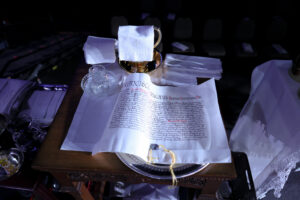
The official Vatican decree declaring Bishop Mark Beckman as the next leader of the Catholic Church in East Tennessee. (Photo Eleyana Nahigan)
The scroll below the shield is inscribed with the bishop’s motto. It is taken from the Letter to the Hebrews: “Jesus Christ is the same, yesterday, today, and forever” (Hebrews 13:8).
The shield is ensigned with external elements that identify the bearer as a bishop. A gold processional cross appears behind the shield. The galero or “pilgrim’s hat” is used heraldically in various colors and with specific numbers of tassels to indicate the rank of a bearer of a coat of arms. A bishop uses a green galero with three rows of green tassels.
Additional terms in the blazon for the Diocese of Knoxville’s coat of arms are “dancetty,” referring to the indentations indicating the mountains (“three points”) in the first quarter of the coat of arms, and “saltirewise,” meaning the diagonal placement of the dogwood blossom in the second quarter. “Fess” refers to the horizontal band in the diocesan coat of arms. “Palewise” indicates the vertical placement of the tulip poplar leaves in Bishop Beckman’s crest. “Of the first,” referring to the three small crosses, means they are the color or tincture of the first color mentioned in the blazon: red (“gules”).
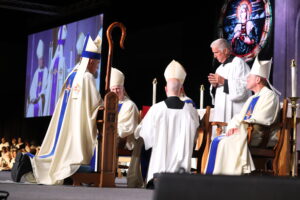
Bishop Beckman receives his crosier from Archbishop Fabre during the July 26 Mass of ordination and installation at the Knoxville Convention Center. Watching are Bishop James V. Johnston Jr. and Bishop J. Mark Spalding as Deacon Walt Otey and seminarian Bobby Denne assist. (Photo Gabrielle Nolan)
Bishop Beckman’s crosier is the same one used by Bishop James D. Niedergeses throughout his time as ninth bishop of Nashville. Both bishops were born in Lawrenceburg, Tenn.
The crosier, hand carved from cedar, was presented to Bishop Niedergeses by the priests of the Diocese of Nashville at his episcopal ordination on May 20, 1975. Originally the crosier was in one piece. Bishop Niedergeses had one of his cousins, Pauly Niedergeses, make it into two sections that could be screwed back together and placed in a carrying case. Pauly also made the carrying case, which is painted with black enamel with brass hardware, and lined with red felt. Bishop Niedergeses used the crosier until his retirement on Oct. 13, 1992. The crosier is 74 inches tall.
Monsignor Owen Campion of Our Sunday Visitor, a native of the Diocese of Knoxville, said that Bishop Niedergeses served “as beloved chaplain” at St. Thomas Hospital in Nashville following his retirement as bishop.
Then-Father Niedergeses was appointed pastor of Our Lady of Perpetual Help in Chattanooga in 1962 when it was among the three largest parishes in Tennessee, Monsignor Campion said. He was instrumental in building Notre Dame High School’s current edifice, completed in 1965, from finding the land to funding to advising on construction and was “very much involved in Chattanooga civic and ecumenical activities,” the monsignor continued.
Father Niedergeses was transferred to Sts. Peter and Paul Parish in downtown Chattanooga in 1973 and was serving there when he was named bishop of Nashville.
Some of the younger priests of the Diocese of Nashville decided to present the new bishop a gift. Simplicity was very much the style under Pope St. Paul VI, who abolished many regalia of bishops, regarding them as too flashy and extravagant, Monsignor Campion said. For his pectoral cross, Bishop Niedergeses chose to wear a simple crucifix given him by his mother when he left Lawrenceburg to attend seminary.
With all this in mind, the young priest decided a crosier of gold, silverplate, or brass would not be fitting. Father David Choby, later bishop of Nashville, had heard of a woodworker in Lebanon, in Wilson County, where cedar trees are especially abundant. He contacted the man, who made the crosier with local cedar. When it was finished, the priests presented it to the new bishop in the second-floor conference room of the old Catholic Center in Nashville.
“He was delighted,” Monsignor Campion said. “He was a great student of the Scriptures, and immediately he recalled references to cedar in Isaiah. He found religious symbols in the fact that cedar is fragrant. It is evergreen, withstanding cold and winter. It stands tall and strong and straight. It repels pests. It is a hard, sturdy wood. It abounds in Tennessee and is deeply rooted in Tennessee, from the Smokies to the bluffs of the Mississippi [River] in the West.”
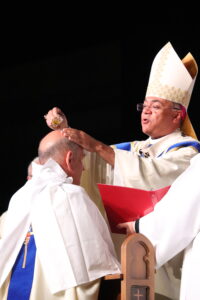
Archbishop Shelton J. Fabre places sacred chrism on Bishop Mark Beckman’s head as part of the Mass of ordination and installation. (Photo Gabrielle Nolan)
Archbishop Shelton J. Fabre, principal consecrator of Bishop Mark Beckman, also presented a ring and a miter to Knoxville’s new shepherd.
The archbishop presented the ring to Bishop Beckman with the words, “Receive this ring, the seal of fidelity: and adorned with undefiled faith, preserve unblemished the Bride of God, the holy Church.” The ring “symbolizes the bishop’s fidelity to the Bride of God, the Church.”
The presentation of the miter was made with the archbishop stating, “Receive the miter and let the splendor of holiness shine in you, so that when the chief Shepherd appears you may merit to receive an unfading crown of glory.”
The miter “signifies the bishop’s resolve to pursue holiness.”
The crosier is presented last, with the words from the archbishop, “Receive the crosier, the sign of the pastoral office, and keep watch over the whole flock in which the Holy Spirit has placed you as bishop to govern the Church of God.”
The pastoral staff is a symbol of “the duty of guiding and governing the Church entrusted to” the new bishop.

